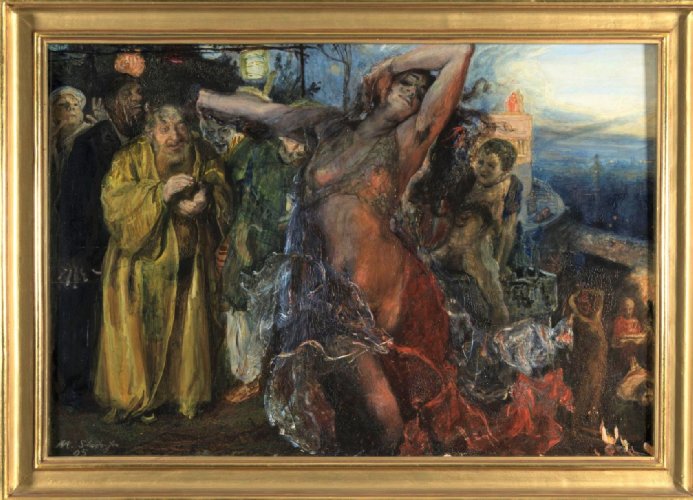Description:
Max Slevogt (1868-1932) was a German painter and graphic artist, a representative of Berlin Impressionism. He studied at the Munich Academy with Johann Herterich and Wilhelm von Diez and then trained at the Julian Academy in Paris. He chose Edouard Manet as his spiritual guide. He was a member of the Berlin Secession society. He was a professor at the Academy of Arts in Berlin. He traveled to Italy, Holland and Egypt. He mostly worked outdoors. His works are characterized by strong brush strokes and a naturalistic palette of colors. Slevogt’s landscapes, historical and religious paintings and still lifes are meticulous studies of light and color*.
Description of the picture:
The picture depicts three intertwining motifs: a sensuous dance, a ‘femme fatale’ – a beautiful woman bringing destruction, and crime. All of this in a decadent atmosphere of the art of the end of centuries – ‘fin de siècle’. The half-naked girl in the center of the scene is Salome, the daughter of Herodias from her first marriage to Herod Philip. It was at her request and under the influence of her dance that John the Baptist was beheaded. Max Slevogt’s depiction of the dance thus becomes a tool of death.
Salome and Herodias have gone down in history, entangled in the imprisonment and tragic death of John the Baptist. This event was described in the texts of the Gospels. John the Baptist publicly condemned Herod Antipas for divorcing his wife and marrying Herodias, who had previously been married to his brother, Herod Philip. The tetrarch’s behavior violated the rules of the Jewish law. Despite the justice of his accusations, the prophet was thrown into prison for proclaiming them. Herodias, accused by John of adultery, wanted to kill him. Herod restrained these desires, fearing the reaction of the crowd, people recognized the Saviour in the Baptist. However, an opportunity appeared, which the woman decided to use. On the occasion of Herod Antipas’ birthday, a great feast was held in Galilee. The guests were entertained by dancers, including the beautiful princess Salome, who decided to show the gathered guests and her stepfather her beauty and dance. Herod was so mesmerized by the charms of his stepdaughter that he promised in front of everyone to fulfill any of her wishes: “Ask me for whatever you want, and I will give it to you. I will give you whatever you ask for, even half of my kingdom” (Mk 6, 22-23). Salome, however, was not interested in riches. At the urging of her revenge-seeking mother, she demanded the head of John the Baptist served on a platter. Herod, not wanting to break the word given, fulfilled the request. He issued an order to behead the prisoner. In this way, Salome’s sensual dance sealed the tragic fate of John the Baptist and forever marked Herod with guilt.
The figure of the dancing Salome is depicted in the foreground. Her body, her hands snake sinisterly to the sound of the music. The woman is consciously tempting with her body. The scene takes place on the terrace of the palace, at the end of the feast. Dawn is beginning. To the left, there are shown the men watching the dancer, headed by Herod Antipas in a golden cloak, clapping his hands. At the bottom, on the right, there is the figure of the naked executioner raising the sword above the head of the imprisoned John the Baptist. Behind him stands the figure of a servant holding the empty platter, on which the head of the prophet will soon be placed. The work presents only the cause and effect of the event – the dance and beheading, we cannot find among the spectators the figure of Herodias. The action of the scene is stopped at the most dramatic moment, in which the worst has not yet happened, but it has already been predetermined. Nothing can be undone.
The dance shown in the picture becomes a symbol of unrestrained senses that tempt healthy reason and consequently lead to the breaking of moral rules. It is a conscious use of charms and susceptible instincts.


